From Chelyabinsk to Cuba: The meteor connection
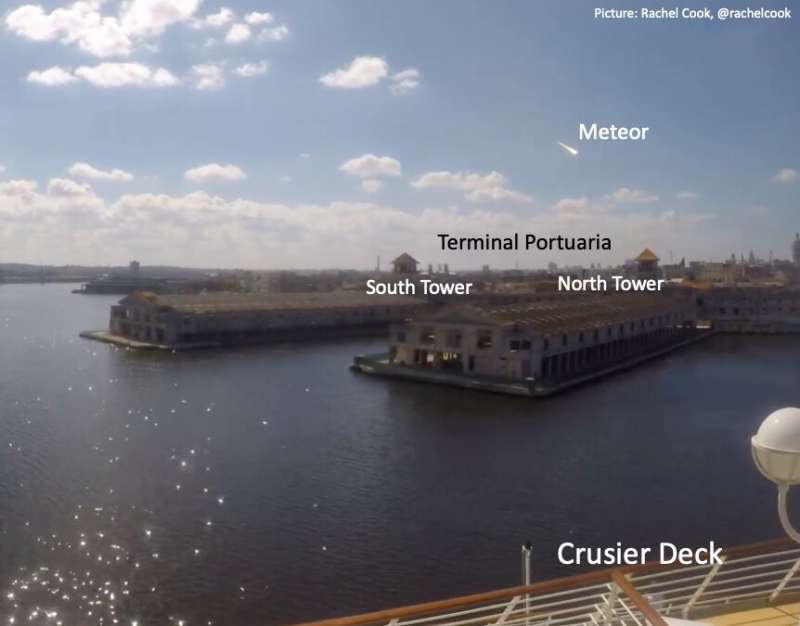
On February 1, 2019 a bright meteor crossed the sky over Cuba in the middle of the day. The phenomenon, which was followed by a smoke trail (a characteristic cloud left by the burn in the atmosphere of a meteoroid) and a sonic boom, was witnessed by thousands of locals and tourists in the region of Pinar del Rio (western side of the island).
Almost at the same time of the impact, a cruise ship was leaving the Havana harbor and on board, Rachel Cook, an American tourist and vlogger, was making a time lapse of the undocking process. Unaware, she accidentally recorded one of the few videos known to date of the falling meteor. Meanwhile, 400 km away, in Ft. Myers beach, Florida, a webcam of the EarthCam network was filming the midday activities in the beach. Luckily, the camera was aimed at the right direction to record the meteor from afar.
Just a couple of minutes after the event, social networks, especially Instagram and Twitter, received a flood of videos and pictures taken from the island, most of them showing the smoke trail left by the meteor. One of those videos was particularly interesting. It was recorded in one of the main streets of the city of Pinar del Rio, and showed tens of people in the street contemplating with awe the remnant cloud (see the video in this link). Although the video does not show the meteor, it was full of details about the place and time when it was recorded.
All these events recalled the incredible experience of the Chelyabinsk meteor in 2013, when a very bright super bolid hit the atmosphere over a populated area in western Russia, becoming the only event of its kind witnessed by humans in almost a century.
Just a couple of days after the Chelyabinsk impact, a team of astronomers of the Institute of Physics in the University of Antioquia led by Professor Jorge I. Zuluaga reconstructed the trajectory of the Chelyabinsk meteor exclusively using videos of the phenomenon posted on YouTube.
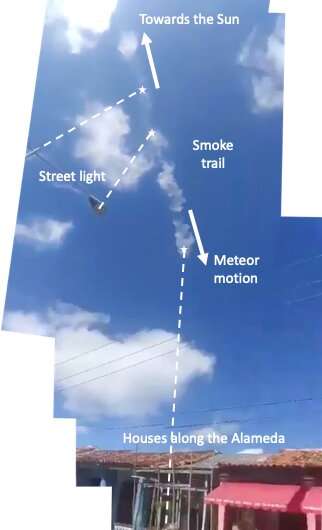
Although many other teams in Russia, the Czech Reublic, Canada and the U.S. also reconstructed the trajectory using more sophisticated methods and data.
Today, just a week after the event and almost exactly six years after the Chelyabinsk impact, the same Colombian scientific team, again using information available on the internet, applied their methods to reconstruct the trajectory of the Cuban meteor. Their results has been included in a scientific manuscript just submitted to a peer reviewed journal. A preprint of the manuscript is available in the Cornell University arXiv lists.
"We were very lucky that at least three relatively reliable videos, including one with an incredible quality, could be available on the Internet in such a short time," explains Zuluaga. "Reconstructing the trajectory of a meteor requires at least three observers on the ground. Although several satellite images were recorded and also available online, without observations from the ground, the precise reconstruction is not feasible."
According to the reconstruction made by the Colombian astronomers, the object producing the meteor over Cuba starts its trajectory inside the atmosphere at an altitude of about 76.5 km above the caribean sea, over a point 26 km to the southwest of the San Felipe Keys (Cuba).
The speed of the rock at its contact with the atmosphere was 18 km/s (64,800 km/h). With such a velocity, the thin air of the high atmosphere was not enough to stop the object, although it was enough to heat it until the rock became bright.
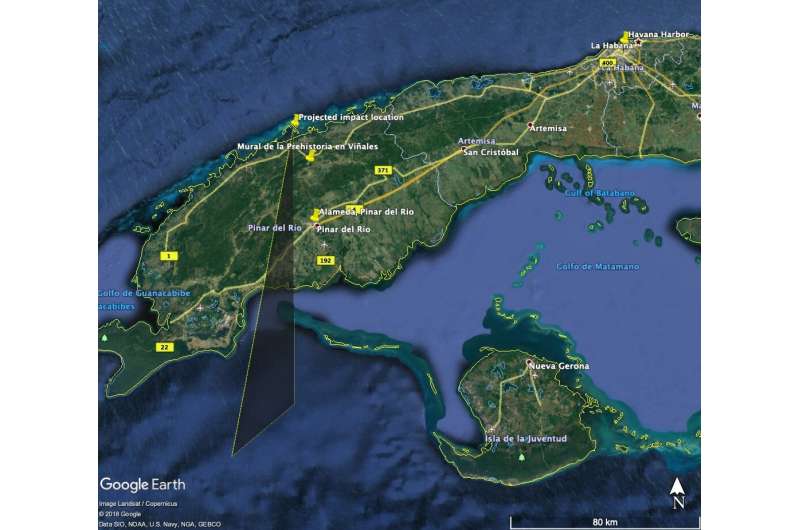
The rock continued its path in an almost straight line until a height of around 27.5 km. It was at about that altitude that the smoke trail, observed by thousands in Cuba and in satellite images, started to develop. Zuluaga and coauthors estimate that the cloud seen in Pinar del Rio corresponds to a small part of the trajectory of the meteor (corresponding to altitudes between 26 and 22.5 km). According to the footage on that city and the reconstruction of the Colombians, the airburst ended at about 22 km.
From there on, hundreds of small fragments that survived the atmospheric ablation fell in many direction without emitting any light (dark flight). Although most of these small rocks probably ended up in the forests of the Viñales Natural Park, some of them hit several houses in the Viñales Valley, close to a touristic landmark, "El Mural de la Prehistoria," six kilometers away from the main path of the object. If a big fragment survived the ablation, it probably landed in the ocean on the northwestern coast of the island.
After reconstructing the trajectory in the atmosphere, the Colombian astronomers played back the impact and found that the culprit, a rock with an estimated size of several meters and a weight of about 360 tons, came from an eccentric orbit around the sun with an average distance of 1.3 astronomical units (1 astronomical-unit = 150 million km). Before impacting the Earth, the rock completed a turn around the sun every 1.32 years. All that came to an end on February 1, 2019, when the rock and the Earth found themselves at the same point in space at the same time.
But reconstructing the trajectory of the meteor was not enough for the Colombian Astronomers. Several groups around the world are probably working right now on their own estimations, some of them using precise satellite data or information from infrasound networks. As the Chelyabinsk impact taught us, this event attracts the attention of many scientists, and it is probable that other works will be published about the impact on the following weeks or months.
More interestingly, the astronomers used their results to test a method that Zuluaga and Mario Sucerquia, who was also a coauthor of this work, developed recently to study asteroid impacts against the Earth and the Moon. The method, called Gravitational Ray Tracing (GRT), applies several algorithms originally devised for the computer graphics industry.
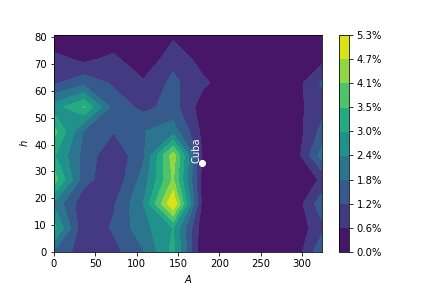
In GRT, the Earth is not hit by asteroids but it is a source of them. Many rocks are launched (in a simulated environment) into thousands of directions in the sky and with different speeds, from a certain geographical location (a beach in the northwest of Cuba or a valley on the moon). The rocks that end up in orbits around the sun, similar to already discovered asteroids, are flagged as potential impactors. The rocks with orbits that are not typical of near-Earth objects (NEOs) are flagged as unnatural objects.
Using the rocks that are flagged as potential asteroids, the astronomers were able to create maps in the sky of the directions from which a real asteroid could arrive. Or at least this is what the theory of Zuluaga and Sucerquia states.
The Colombian astronomers found that their theoretical method predicted what Cubans saw: a rock coming from the south in a trajectory inclined around 30 degrees with respect to the horizon.
In order to check if this result was not just the product of chance, they performed a similar calculation on the Chelyabinsk event. Again, the method predicted that at the time and location of the Russian impact, the most probable region in the sky from where an asteroid could arrive was looking toward the northeast, at an elevation of 20 degrees. The actual object appeared almost in the direction of the east and at exactly 20 degrees of elevation.
But still, the coincidence between the predictions of GRT and the actual conditions of the Chelyabinsk and Cuba impact could also be random. However, it could also reveal a deeper truth, namely the fact that the researchers could predict the direction in the sky from which a meteor could arrive into the city (if that impact actually occurs).
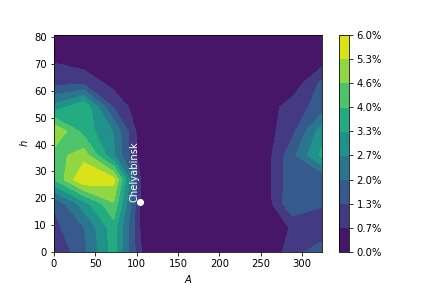
"Only after the recent digital boom we have realized how frequent and potentially hazardous could the impact of small meteoroids on populated areas," says Mario Sucerquia. He adds, "Sadly we are not yet able to defend our society against this threat; our work suggests that in principle, we could be prepared, at least with some knowledge, for future impacts."
Prof. Pablo Cuartas, co-author of the paper, says, "The relatively small size of meteoroids like those that fell in Chelyabinsk and Cuba made them practically undetectable before the impact. Since detection is almost impossible, the risk that damaging events like this will happen over very populated areas is high; our results suggest that we can predict in advance at least from which direction they will come."
Finally, he says, "We should be prepared for the next projectile."
Mario Sucerquia is even more direct: "We should check impact probabilities all the time at least in populated areas; doing this as part, for instance, of a public protocol, may help us to take preventive measures in the face of impact threats."
More information: Data and software developed for the work: github.com/seap-udea/MeteorTrajectories.
Can we predict the impact conditions of meter-sized meteoroids? arxiv.org/abs/1902.03980
Jorge I Zuluaga et al. Towards a theoretical determination of the geographical probability distribution of meteoroid impacts on Earth, Monthly Notices of the Royal Astronomical Society (2018). DOI: 10.1093/mnras/sty702
Journal information: Monthly Notices of the Royal Astronomical Society
Provided by Universidad de Antioquia





















